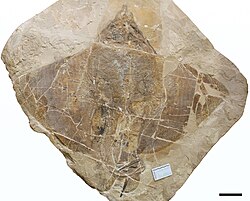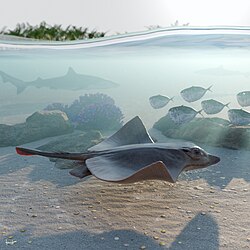Biology:Dasyomyliobatis
| Dasyomyliobatis | |
|---|---|

| |
| Holotype specimen | |
| Scientific classification Error creating thumbnail: Unable to save thumbnail to destination
| |
| Domain: | Eukaryota |
| Kingdom: | Animalia |
| Phylum: | Chordata |
| Class: | Chondrichthyes |
| Subclass: | Elasmobranchii |
| Superorder: | Batoidea |
| Order: | Myliobatiformes |
| Family: | †Dasyomyliobatidae Marramà et al, 2023 |
| Genus: | †Dasyomyliobatis Marramà et al, 2023 |
| Species: | †D. thomyorkei
|
| Binomial name | |
| †Dasyomyliobatis thomyorkei Marramà, Villalobos-Segura, Zorzin, Kriwet & Carnevale, 2023
| |
Dasyomyliobatis is an extinct stingray genus in the monotypic family Dasyomyliobatidae, of the order Myliobatiformes.[1] It contains a single species, D. thomyorkei, known from the Eocene Monte Bolca Lagerstätte of Italy. The specific epithet references English musician and Radiohead vocalist Thom Yorke.[2]
The genus is characterized by a unique hybrid dentition and pectoral fin morphology that allowed the shift from undulatory to oscillatory swimming (and a resulting shift from a benthic to pelagic lifestyle), and to exploit a variety of prey from soft-bodied to hard-shelled organisms.[3] As suggested by the genus name, it displays intermediate traits between the whiptail stingrays (Dasyatidae) and the eagle rays (Myliobatidae), and can thus be considered a transitional form in the origin of pelagic rays. Dasyomyliobatidae is thought to represent a sister group to the Myliobatidae, and the two groups likely diverged during the Late Cretaceous.[2]
The Monte Bolca formation is thought to represent a shallow sea of the Tethys Ocean with scattered coral reefs and seagrass beds. With its combination of traits, Dasyomyliobatis may have been able to forage in both these shallow-water ecosystems as well as the open ocean.[2]
References
- ↑ Dasyomyliobatidae - Zoobank.org
- ↑ 2.0 2.1 2.2 Marramà, G.; Villalobos-Segura, E.; Zorzin, R.; Kriwet, J.; Carnevale, G. (2023). "The evolutionary origin of the durophagous pelagic stingray ecomorph". Palaeontology 66 (4): e12669. doi:10.1111/pala.12669. PMID 37533696. Bibcode: 2023Palgy..6612669M.
- ↑ Anderson, Natali (2023-11-13). "50-Million-Year-Old Fossil Helps Clarify Origin of Pelagic Lifestyle and Durophagy in Stingrays | Sci.News" (in en-US). https://www.sci.news/paleontology/dasyomyliobatis-thomyorkei-12444.html.
Wikidata ☰ Q123561542 entry
 |


